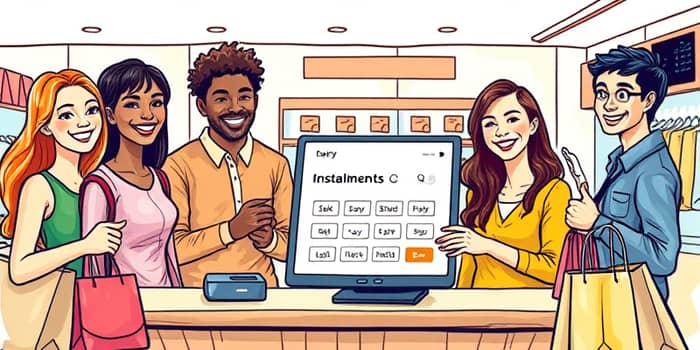
In today’s fast-paced retail environment, consumers crave flexibility and control over their finances more than ever before. Installment plans at the point of purchase have emerged as a transformative payment solution that empowers shoppers to manage large expenses with ease. By offering structured payment schedules directly at checkout, merchants and financial institutions can unlock new revenue streams, while customers benefit from greater purchasing power and reduced financial stress.
Across brick-and-mortar stores and online platforms alike, these innovative financing options are reshaping how people shop. The ability to spread costs over multiple payments transforms impulsive decisions into responsible commitments, enabling purchases of electronics, travel packages, fashion, and even everyday essentials without straining immediate budgets. As this model gains traction, retailers and brands must understand how to integrate it seamlessly, balancing growth with consumer protection.
Installment plans—often branded as Buy Now, Pay Later (BNPL)—allow buyers to divide the total purchase amount into installments with fixed payment schedules. At checkout, customers choose a plan, usually spanning several weeks or months, and pay smaller, predictable amounts rather than a lump sum. Interest rates vary by provider, with some offering interest-free periods or minimal fees.
These services can be embedded by merchants, provided by card issuers, or delivered via third-party platforms. Popular players include Affirm, Afterpay, Klarna, American Express Plan It, and Citi Flex Pay. Whether scanning a QR code in-store or clicking a button online, customers complete a streamlined approval process and receive instant access to the chosen plan. This functionality is increasingly integrated within mobile wallets and digital cards, ensuring a frictionless experience across channels.
The global BNPL market is on an impressive growth trajectory. From $378.3 billion in transaction volume in 2023, industry analysts forecast a surge to $680 billion by 2025. In the United States alone, BNPL spending is projected to reach $122.26 billion in 2025, growing at a compound annual rate of 12.2%. The U.S. market has sustained a 20.3% CAGR from 2021 to 2024 and is expected to maintain robust expansion through 2030.
As of 2022, roughly 360 million people worldwide have used BNPL services, and 60% of global consumers have tried them at least once. Usage peaks during high-spending seasons—holidays, back-to-school sales, and promotional events—underscoring the role of installment plans in driving impulse and planned purchases alike.
Integrating installment options at checkout delivers tangible advantages for businesses and customers. Merchants experience higher conversion rates as price-sensitive shoppers proceed to complete their purchases. Reduced cart abandonment, improved average transaction sizes, and stronger brand loyalty are common outcomes.
For consumers, installment plans offer more than just convenience. Spreading payments over time can help buyers avoid credit card interest, align spending with income cycles, and plan major purchases without depleting savings. When used responsibly, this approach fosters empowerment and confidence.
Savvy shoppers often combine multiple providers to optimize terms, using promotional no-interest periods or minimal-fee plans for essential and discretionary spending alike. Over 200 BNPL companies operate globally, giving consumers a rich ecosystem to choose from.
Despite the clear benefits, installment plans carry potential downsides. Sixty-six percent of users express worries about overspending or accumulating unmanageable debt. Easy approval processes, multiple concurrent plans, and seasonal promotions can lead to missed payments and financial strain.
Providers are responding by implementing data-driven risk assessment and personalization protocols, leveraging big data and AI to evaluate creditworthiness, set spending limits, and offer tailored recommendations. Shoppers must also remain diligent, tracking due dates, maintaining emergency funds, and treating installment plans as structured commitments rather than short-term credit boons.
To enhance budgeting and financial discipline, consumers should consider only those purchases they can realistically afford, set reminders for payment deadlines, and review statements regularly. Combining BNPL with budgeting apps can create a clear picture of outstanding obligations and monthly cash flow.
The installment plan ecosystem continues to evolve. Traditional credit card issuers are increasingly embedding BNPL features, blending familiarity with innovation. This trend of overcoming traditional credit limitations effectively positions cardholders to enjoy the convenience of pay-over-time without separate account setups.
Regulators around the world are paying closer attention to consumer protection in the BNPL space. Requirements for clear disclosures, caps on late fees, and standardized underwriting practices are under discussion to balance innovation with responsibility. Meanwhile, providers leverage advanced analytics to refine marketing, streamline approvals, and personalize offers, driving sustained engagement.
Installment plans at the point of purchase represent a paradigm shift in retail financing. By offering structured, predictable payment schedules, merchants unlock significant sales potential while consumers gain unprecedented financial flexibility. As the market matures, responsible usage, transparent practices, and regulatory safeguards will ensure this model continues to thrive.
Whether you’re a retailer exploring new growth levers or a shopper seeking smarter ways to budget, embracing installment plans today can lay the foundation for more empowered and sustainable purchasing decisions tomorrow. Start the conversation with your financial provider or retail partner, and harness the power of pay-over-time solutions to transform your buying experience.
References













